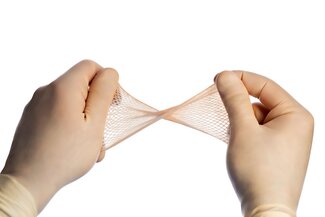TheraSkin Product Specifications

TheraSkin®
Living Cell Skin Allograft
TheraSkin is an all-human, split-thickness skin allograft with living cells and retained endogenous growth factors, and a native extracellular matrix. TheraSkin can be vascularized by the recipient following transplantation to support development of granulation tissue, which aids in epithelialization to support wound closure.1-3
- Retained Endogenous Growth Factors: Growth factors and cytokines naturally present in the donated tissue are retained in the donor’s extracellular matrix, to support angiogenesis.3
- Intact ECM: TheraSkin ECM provides a natural skin environment to enable a number a functions, including structural support, a substrate for cell movement, and direct interactions with the recipient cells to help facilitate and support healing.3
- Living Cells: Viable fibroblasts and keratinocytes, the living cells found within human skin, are critical to support healing of the patient’s damaged or diseased skin.4
Clinical Application
A barrier membrane for chronic wounds including:
- Diabetic Foot Ulcers
- Venous Statis Ulcers
- Pressure Ulcers
- Dehisced Surgical Wounds
References
- Flood MS, Weeks B, Anaeme KO, et al. Treatment of deep full-thickness wounds containing exposed muscle, tendon, and/or bone using a bioactive human skin allograft: a large cohort case series. Wounds. 2020;32(6):164-73.
- Barbul A, Gurtner GC, Gordon H, Bakewell K, Carter MJ. Matched-cohort study comparing bioactive human split-thickness skin allograft plus standard of care to standard of care alone in the treatment of diabetic ulcers: A retrospective analysis across 470 institutions. Wound Repair Regen. 2020;28(1):81-9. doi:10.1111/wrr.12767.
- Gurtner GC, Garcia AD, Bakewell K, Alarcon JB. A retrospective matched-cohort study of 3994 lower extremity wounds of multiple etiologies across 644 institutions comparing a bioactive human skin allograft, TheraSkin, plus standard of care, to standard of care alone. Int Wound J. 2020;17(1):55-64. doi:10.1111/iwj.13231.
